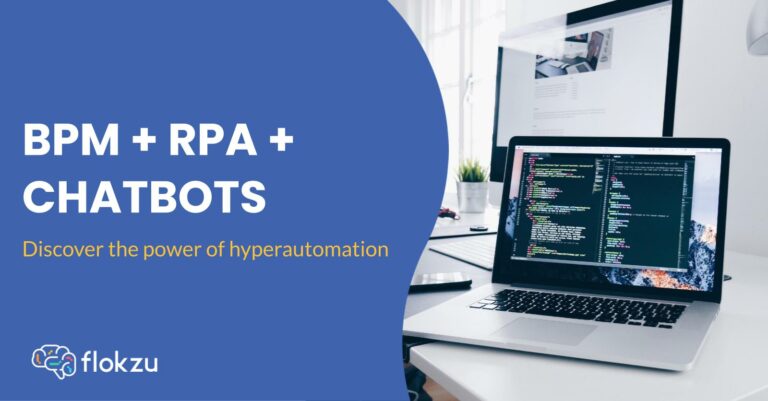In the current era, hyper-automation has emerged as one of the most relevant and transformative technology trends in the business world. Through the combination of technologies such as Business Process Management (BPM), Robotic Process Automation (RPA) and Chatbots, organizations are experiencing a revolution in the automation of their processes. In this blog, we will explore in detail what hyper-automation is, its essential components and how it impacts the business world. In addition, we will tell you about the Panel that took place at Flokzu Academy between three leaders of large automation companies.
What is Hyper-automation?
Hyper-automation, also known as digital process automation (DPA) or intelligent process automation (IPA), is a technological strategy that goes beyond simply mechanizing repetitive manual tasks. It consists of automating any business process by using a combination of advanced technologies such as Artificial Intelligence (AI), Business Process Management (BPM), Machine Learning (ML) and Robotic Process Automation (RPA). Hyper-automation seeks to identify and automate as many processes as possible, as quickly as possible, in search of greater efficiency and accuracy in business operations.
This strategy represents an evolution in process automation by allowing multiple workflows to be automated simultaneously, thus unifying different operational areas in a company and accelerating the adoption of automation throughout the organization. Hyper-automation, through the integration of different empowering technologies, not only seeks to mechanize specific tasks but also to understand and improve business processes as a whole, which can lead to a profound transformation in the efficiency and productivity of an organization, as well as reducing costs and improving the quality of the products or services delivered.
The Fusion of BPM, RPA and Chatbots in Hyperautomation
What is BPM?
Business Process Management is a discipline that involves the modeling, automation, execution, control, measurement and optimization of business activity flows. In short, it is a way to manage and improve a company’s internal processes to achieve business goals, improve efficiency and quality, and deliver a better experience to customers and partners. The BPM lifecycle includes several phases, including process design and modeling, process execution and control, and continuous optimization to achieve desired results. Through BPM technology, companies can increase visibility into processes, identify inefficiencies and achieve continuous improvement without large investments, integrating this management with other enterprise systems.
What is RPA?
Robotic Process Automation is a technology that uses software robots or “bots” to automate repetitive and structured tasks within a workflow. These bots can perform actions such as copying and pasting data, interacting with applications, sending emails and performing similar tasks that previously required human intervention. RPA provides a fast and scalable way to automate business processes, improving efficiency, reducing errors and freeing employees from monotonous tasks so they can focus on higher value-added activities.
What are Chatbots?
They are artificial intelligence programs that interact with users through written or spoken conversations. These bots use natural language processing (NLP) to understand and respond to user queries and requests in a contextual and consistent manner. Chatbots are used in various applications, such as customer service, technical support, reservations, sales and more, to respond quickly and accurately to frequently asked questions and repetitive tasks.
The union of these three powerful technologies
The fusion of BPM, RPA and Chatbots in Hyperautomation represents a powerful combination of technologies that further empowers business process automation and takes digital transformation to an unprecedented level. Hyper-automation, as a strategy that extends automation beyond the boundaries of individual processes, benefits significantly from the integration of tools such as Robotic Process Automation (RPA), Process Modeling (BPMN), Artificial Intelligence (AI) and Machine Learning (ML).
At the core of this fusion is AI- and ML-enriched RPA, which enables the automation of repetitive tasks and more complex processes that previously required human intervention. In addition, Hyperautomation goes beyond simple automation, as it uses dynamic process discovery to identify opportunities for automation, significantly accelerating the pace of digitization.
On the other hand, Artificial Intelligence (AI) and Machine Learning (ML) add cognitive capabilities to Hyperautomation, enabling bots to analyze unstructured data, learn from human interactions and make more intelligent, more accurate decisions.
The incorporation of Chatbots is also a key component in this technological synergy. Powered by AI and ML, Chatbots can interact with business users and customers to provide quick and accurate responses to queries, perform tasks, and improve user experience. Integrating Chatbots into Hyperautomation enables smoother and more effective communication between humans and automated systems, leading to greater efficiency and productivity in business operations.
The combination of BPM (Business Process Management), RPA and Chatbots in Hyperautomation results in a complete digital transformation of business processes.
BPM provides the basis for modeling, optimizing and managing workflows and business processes. At the same time, RPA enables rapid and scalable automation of repetitive tasks, which can be part of a larger process formally modeled in the BPM Suite, and Chatbots enhance the interaction between humans and automated systems. This technological synergy enables organizations to achieve higher efficiency, agility and accuracy, freeing employees from monotonous tasks so they can focus on higher-value activities and strategic decision-making. Hyper-automation can include many other technologies besides these three, and the key is to make the best use of those available. This also implies applying only those that deliver a relevant benefit for automating a set of company tasks and not applying technologies just because they are innovative or modern.
Hyper-automation can include many other technologies besides these three. The key is to make the best use of those available. This also implies applying only those that deliver a relevant benefit for automating a set of company tasks and not applying technologies just because they are innovative or modern.
Flokzu Academy: Hyper-automation Panel: BPM + RPA + Chatbots
Last June 30, as part of Flokzu Academy, we brought together leading representatives of BPM, RPA and Chatbots technologies to discuss their application and benefits in the field of business automation. The speakers were:

- Petros Pilides – CEO of Softbotic, a software robot tool that emulates human tasks, trained to perform flows in computer systems.
- Juan Moreno – Founder and Chief Strategist of Flokzu, a low-code BPM platform for automating simple and complex business processes with a drag-and-drop interface.
- José Luis Horta – Co-founder of Simpletech, a company dedicated to optimizing customer experience through automated messaging and chatbots powered by artificial intelligence.
Manuel Gros, CEO of Flokzu, was the moderator of this panel and led the discussion between these experts about integrating their tools for Hyperautomation.
Each of them had the opportunity to tell us about some success stories where process automation brought significant changes:
José Luis, from Simpletech, told us about two success stories. In one of them, through the integration of a chatbot, the claims notification process was automated in a car insurance company. Through WhatsApp, customers are able to generate a case, send photos in real-time and get assistance, reducing the attention time from 1 hour to 8 minutes on average, without the need to contact an agent unless necessary.
Petros, from Softbotic, told about a successful case in a financial institution where robotic automation was applied in a credit factory process, for which they selected the most manual tasks that were shown in the BPM and the workflow already built. They reduced the time from when the application was made and the credit was granted, from 10 to 4 days, achieving a more efficient process.
Juan, from Flokzu, also told a success story within the financial sector. In which in a Latin American bank and through the automation of its loan process, they were able to reduce by 70% the amount of manual interactions that the bank had with customers, achieving a better experience and satisfaction through the effectiveness of the process.
Juan also told us about the onboarding process within the Human Resources area.
The three of them also discussed how each technology can feed off the other, how Artificial Intelligence impacts the digital transformation and what advice they would give to a company that wants to get started in the hyper-automation of its processes. You can watch the full panel below for more details on these topics. Also, you can register at Flokzu Academy and access the free courses, masterclasses and certifications here.
Conclusion: Hyper-automation as an indispensable ally for the future of enterprises
Hyper-automation has emerged as a revolutionary technological trend promising to transform business efficiency radically. Its importance lies in its ability to enable organizations to analyze their processes and find creative opportunities for automation thoroughly. Although it started out being adopted by large companies, its evolution has led to cost reduction, allowing even SMEs to use it to improve efficiency, competitiveness and cost savings.
The implementation of hyper-automation has rapidly spread to various sectors, such as energy, finance and retail. By harnessing its potential, organizations can anticipate change, increase productivity, free employees from repetitive tasks and focus their professionalism on more creative and strategic aspects.
You can also schedule a work session here so that we can model, together with you, a real process of your organization!




























